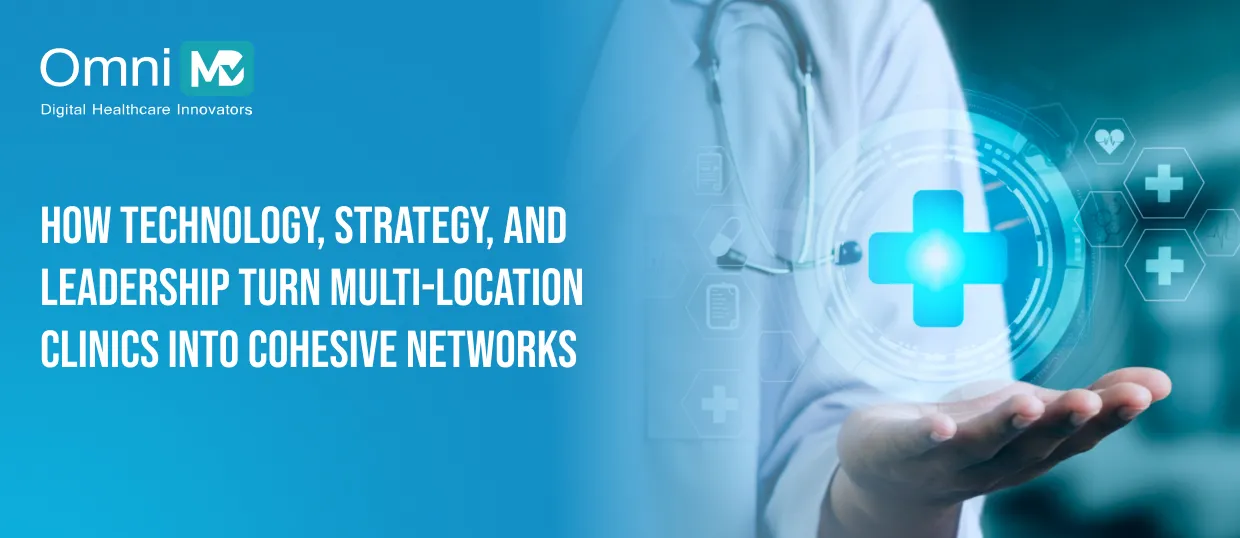How Multi-Location Urgent Care Clinics Can Stay Efficient
Urgent care used to be a side door to healthcare. A place people went when their doctor’s office was closed and the emergency rooms felt like overkill. But that has changed. Now, for a growing number of Americans, it’s the only door that feels open.
After COVID, after insurance headaches, after all the ‘wait two weeks to be seen’ thing, urgent care has quietly become the front line of care delivery. And if you’re running one, you’ve probably felt the pressure of rising patient volume, the expectations, and the urge to grow… fast.
But here’s the catch. Scaling may sound exciting, but it is also a deeply strategic process. This is because ensuring the new clinic still feels like you after it opens takes more than tools and dashboards. It takes judgment, clarity, and serious operational thinking.
And that’s the hard part.
This blog looks deeper into what scaling urgent care really demands, what breaks, what bends, and what has to evolve when you move from one clinic… to many.
Let’s begin.
Nascent Stage: One Clinic Becomes Two and Everything Gets Exposed
When you open a second location, you start to see how much of your first clinic’s magic came from your presence. You knew the team. You could course-correct in the moment. You instinctively solved edge cases. Now all that has to live somewhere outside of you.
You need to externalize the invisible:
- The tone you expect at the front desk
- How rooms are turned over
- What follow-up really means
- How shift leads think, speak, and act
Because the second clinic won’t ask. It will guess. And this is when you realize:
- You don’t have workflows. You have habits.
- Your EHR is only ‘standard’ when you are using it.
- Your new staff is being trained by whoever has five free minutes.
This is the moment to pause. Write things down. Define your clinic’s operating system.
Because without this clarity, every new site drifts further from what made you special.
And while you’re at it, this is the ideal time to quietly build the technical skeleton. Not big, flashy tech, just foundational moves that future-proof scale:
- Set up a shared SOP hub (Notion, Confluence, or even Google Docs) as your operational source of truth.
- Use simple APIs or webhooks to sync patient intake data across clinics.
- Start normalizing EHR data into a basic dashboard (Google Data Studio or Metabase) to track visits, referrals, and throughput.
- Add audit logging, track who made what change, and why
In this way, you teach your business how to think like a system.
Maturing Stage: 3 to 6 Clinics and the Cracks Become Systems
This is the trickiest phase. You look around and think: “We’re doing it. We’re scaling.” But underneath? Entropy.
One clinic uses digital intake. Another forgot it existed. Billing at one site runs like a Swiss watch. Another runs on sticky notes. Your EHR workflows are ‘getting there’, but so is the chaos.
This is where most people reach for more tech. It makes sense, you see disconnection and think, there must be a tool for this. There is. But tools don’t fix disconnection. Clarity does.
Before you buy anything new, define:
- What must be identical across all clinics?
- What’s okay to flex?
- How does a patient know, no matter where they walk in, that they’re in your care?
When you nail those answers, the right tech becomes obvious:
- One Urgent Care EHR that actually works the same across locations
- A dashboard that pulls live data, not something rebuilt in Excel every Friday
- Digital intake that isn’t optional
- Telehealth that isn’t a patch
- Load balancing logic for patient flow
And most importantly? A culture that doesn’t depend on you walking into the room.
At this point, your tech decisions begin shaping your growth speed.
Here’s what that looks like:
- EHR Configuration Management: Centralize visit types, templates, protocols, and intake flows. Keep it consistent, deploy it widely.
- Analytics Layer: Move to real-time dashboards (Power BI, Tableau, Metabase) fed by a cloud data warehouse (BigQuery, Snowflake). Track per-clinic throughput, no-shows, and documentation lag.
- Integration Middleware: Use Zapier or custom FastAPI services to bridge your CRM, HR, billing, and inventory, reduce manual glue.
- Standardized Onboarding: Design a 30-60-90-day plan for every new hire. Deliver it through an LMS like Trainual or TalentLMS. Make sure every MA, front desk, or NP starts with the same playbook.
- Operational Rhythms: Hold cross-clinic ops huddles, not for checklists, but for truth-telling.
- Reputation Visibility: Share online reviews across the team. Let them see how their work ripples out.
People don’t need perfection. They need consistency. But you have to give it to them.
Fully-Grown Stage: 7+ Clinics and You Stop Running Clinics and Start Running a System
Once you hit seven or more clinics, the game changes. You’re not walking the floor anymore. You’re watching dashboards. Spotting trends. If your systems are weak, they’ll betray you, first quietly, then all at once.
Now, the real risks are the boring ones:
- Payroll glitches that quietly demoralize teams
- Credentialing delays that leave shifts uncovered
- Charting that slowly drifts from compliance
- Tasks no one owns because no one realized they were dropped
This is where automation stops being a luxury and becomes a life raft. Not to replace people but to protect them.
Automate things like:
- Geofenced punch-ins so time tracking stays clean
- Credentialing alerts before expiration become a disruption
- Performance reviews powered by patient sentiment, chart quality, and coverage history
At this stage, your technical architecture becomes operational armor.
- Event-Driven Architecture: Use tools like Kafka or AWS SNS to trigger workflows, for example, a patient checks in → chart preps → MA gets alert → timer starts for wait SLA.
- Role-Based Access (RBAC): Lock sensitive EHR access to roles using Okta, Firebase Auth, or similar IAM tools.
- Credentialing Pipeline: Integrate Medallion or state boards directly for license verification and expiration alerts.
- AI Review Layer: Use GPT-4 or AWS Comprehend Medical to flag vague notes, missing data, or incorrect coding in real time.
- Patient Identity Resolution: Avoid duplicate charts across sites using master patient index (MPI) logic.
Moreover, at this size, patients don’t remember the logo. They remember how they felt. So start with small habits that leave big impressions:
- Send follow-up texts within 24 hours of check-in
- Deliver visit summaries to their phone before they ask
- Flag returning patients so the front desk doesn’t ask “Have you been here before?”
- Offer telehealth rechecks instead of dragging people back in
Even your reviews are now signals in a much larger system. A bad review at one clinic? That’s a local issue. At ten? It’s a warning.
Because now, it affects:
- Your search results
- Your referral relationships
- Your contracts with employers or payers watching from the sidelines
So bake in:
- Automated review requests after each discharge
- Real-time routing of negative feedback, not to an inbox, but to someone who will act
- Thoughtful replies, no copy-paste apologies
- Internal reputation rounds, share patient wins, learnings, and breakdowns
If you’re forward-looking, take it a step further:
- Build a sentiment analysis dashboard using Google NLP or OpenAI.
- Spot frustration patterns before they become public reviews.
That’s how you scale trust. Not with spin. With listening.
The Bottom Line is You’re Not Scaling a Business. You’re Scaling a Promise.
Every urgent care brand starts with a vision: to deliver care that’s fast, reliable, and compassionate. But the further you scale, the harder it is to keep that promise intact.
That’s why this journey, from nascent to maturing to fully grown is all about alignment. It’s about using the right systems, at the right stage, with the right level of leadership. Because in the end, patients don’t care how many clinics you own. They care whether you showed up for them, consistently, every time.
So build smart. Grow slowly if you need to. But never lose sight of the experience you’re scaling. Because that’s what patients remember. And that’s what will last.
Interested in knowing how we help you scale with ease?
Let’s get on a 15-minute discovery call!

Urgent Care Efficiency Across Locations
Simplify staffing, scheduling, and billing across all your clinics with zero chaos and full control.

 Written by Neha Singh
Written by Neha Singh